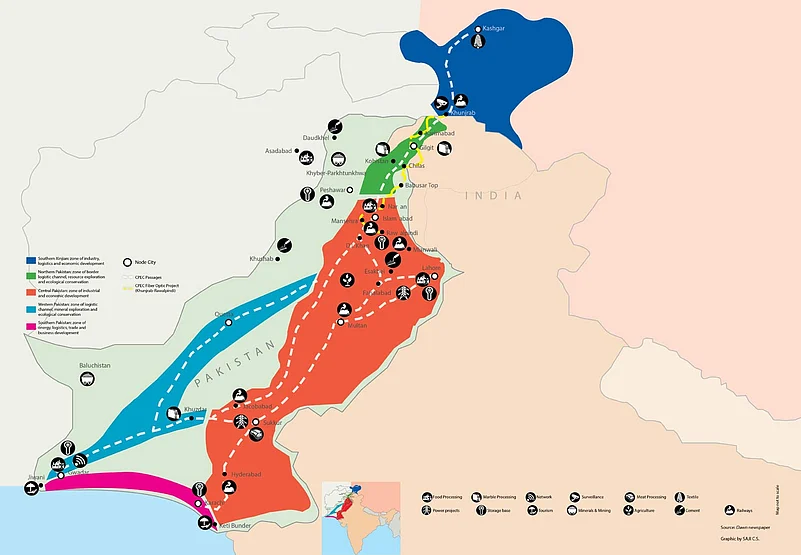Industry
- Mineral extraction: Balochistan and Khyber-Pakhtunkhwa for chrome ore, gold and diamond
- Marble: Twelve marble and granite processing sites in Gilgit and Kohistan in the north and Khuzdar in the south
- Textile: Central zone marked for textile, household appliances and cement
- Cement production: Four clusters in Daudkhel, Khushab, Esakhel and Mianwali
- Southern zone: Petrochemical, iron and steel, harbour industry, engineering machinery, trade processing and auto & auto parts assembly
- Gwadar: Entreport and direct hinterland connecting Balochistan and Afghanistan—location for heavy and chemical industry such as iron and steel and petrochemical.
- Textile: Industry for yarn and coarse cloth and market for cheap raw materials and development of textile and garments, it could help soak up surplus labour force in Kashgar

Fibreoptics and Surveillance
- Terrestrial cable: Across Khunjerab pass to Islamabad and submarine landing at Gwadar—can also lead to linking of Islamabad with all major cities of Pakistan.
- Expanded bandwidth: Will help open terrestrial broadcast of digital HD television, called Digital Television Terrestrial Multimedia Braodcasting, to dissemninate Chinese culture into Pakistan
- Surveillance: Electronic monitoring and control system for the border in Khunjerab with deployment of explosives detectors, scanners to cover major roads, case prone areas and crowded places in urban areas
- Safe city: To be set up in Peshawar and extended to other cities like Islamabad, Lahore and Karachi with shared feeds and recordings
Tourism and recreation
- Keti Bunder to Jiwani: The entire belt near Iranian border will have yacht wharfs, cruise homesports, nightlife, city parks, public squares, theatres, golf courses and spas, hot spring hotels and water sports
- Integrated cultural centres: Attempt to develop coastal vacation products, Islamic culture, historical culture, folk culture and marine culture and integrate them
Agriculture (Mainly in Punjab)
- Spread over 6,500 acres will have two demonstration projects for crops—one for high yield seeds and the other for irrigation techniques
- Meat processing plants: To be set up in Sukkur, a district in Sindh, with an annual output of 200,000 tonne
- Storage bases: Islamabad and Gwadar—Karachi, Lahore and Peshawar
- Vegetable and food processing plants: Asadabad, Islamabad, Lahore and Gwadar
- Cotton processing plant: 100,000 tonnes output annually
- Three level warehousing system: Purchase and storage warehouse, transit warehouse and port warehouse
Ten Major Power Projects in CPEC
- Port Qasim Electric Company Coal Fired, Sindh—1330 MW
- Sahiwal Coal-fired Power Plant, Punjab—1330 MW
- Engro thar Coal-fired, Thar, Sindh—1320 MW
- Rahimyar Khan Coal Power Project, Punjab—1320 MW
- SSRL Mine Mouth Power Plant,Sindh—1320 MW
- Zonergy Solar Park, Bahawalpur, Punjab-900 MW
- Gaddani Power Park Project –(jetty plus infrastructure)—1320 MW
- Kohala Hydel Project, AJK—1100 MW
- Thar mine mouth oracle, Thar Sindh—1320 MW
- Muzaffargarh Coal Power Project, Punjab—1320 MW
Major Railway Projects
- 560-kilometre track from Bostan to Kotla Jam on the main line II, via Zhob and Dera Ismail Khan
- 682 kilometre from Havelian to Khunjerab
- 1,872 kilometre track upgradation from Karachi to Peshawar via Kotri, Multan, Lahore and Rawalpindi (including Taxila_Havelian) alongwith dualisation of Shahdara to Peshawar track
- 1,254 kilometre track to be upgraded from Kotri to Attock city via Dadu, Larkana, Jacobabad, Dera Ghazi Khan, Bhakkar and Kundan
Source: Dawn newspaper















